Access Agilent eNewsletter, March 2014
>> Update My Profile | Subscribe to Access Agilent | Article Directory
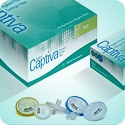
Agilent Captiva Premium Syringe Filters provide fast, easy sample filtration for HPLC and LC/MS analysis
By Limian Zhao and William Long
Agilent Applications Chemists
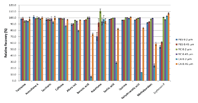 Enlarge
Enlarge
Figure 1. Filtration recovery evaluation results for 100% aqueous sample media, 95% confidence index, n = 6. Thirst Quencher samples directly filtered prior to HPLC injection, relative recovery (%) = normalized peak area ratio for filtered sample compared to a centrifuged sample.
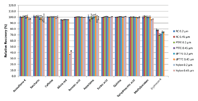 Enlarge
Enlarge
Figure 2. Filtration recovery evaluation results for aqueous/solvent sample media, 95% confidence index, n = 6. Dietary drink samples diluted with MeOH to generate a 1:1 MeOH:water sample medium, vortexed and filtered prior to HPLC injection, relative recovery (%) = normalized peak area ratio for filtered sample compared to centrifuged sample.
Sample filtration prior to HPLC, UHPLC, LC/MS, GC, or GC/MS analysis is critical to achieving optimal system performance. Agilent Captiva Premium Syringe Filters make the process faster than ever with the industry’s highest flow rates and loading capacities. In addition, Agilent sets the standard for LC/MS testing – certifying more syringe filters as completely free of observed extractables than any other manufacturer. All Agilent Captiva Premium Syringe Filters are supplied with a HPLC or LC/MS Certificate. Choose from a variety of membrane types and pore sizes to suit your needs. In this article, we highlight several examples here, to demonstrate the versatility of Agilent Captiva syringe filters when used with very different matrixes.
Excellent filtration recovery and particulate removal for food samples
Filtration using syringe filters is an easy, simple, efficient, and robust sample preparation technique for the analysis of food additives in beverages and drinkable food products. Prior to HPLC analysis, beverages can be directly filtered or diluted followed by filtration. Figure 1 and Figure 2 show the relative recoveries, which are peak area comparisons of analytes in a filtered sample to those in a centrifuged sample. Assuming no analyte loss by centrifugation, the closer the peaks in filtered samples with those in centrifuged samples, the higher the filtration recovery.
The selection of filters – including membrane type, pore size, and filter dimension, depth or regular filter – is based on the sample medium and matrix, the properties of target analytes and the needs of instrument analysis. For products containing large amount of particulates, such as fruit juice, we recommend using depth filters to prevent the filter membrane from clogging easily. To prevent unwanted loss during filtration, we suggest conducting a quick-recovery evaluation prior to the use of filters for real-world samples. For food additives analysis in beverage samples, Agilent Captiva Premium regenerated-cellulose syringe filters are an attractive choice, providing excellent filtration recovery and particulate removal efficiency.
Accurate results with appropriate filters for a variety of drug assays
Membrane, sample matrix, and drug chemistry can affect the potential adsorption of drug products during filtration, and so selection of the appropriate filters (membrane type, membrane pore size, and filter size) is critical to achieve accurate and precise results. Agilent Captiva Premium syringe filters with PTFE, nylon, regenerated cellulose, and PES membranes, with and without prefilters, demonstrate excellent recoveries and compatibility with centrifugation for a variety of drug assay sample preparations, as captured in Table 1.
Acetaminophen |
Ibuprofen |
Ranitidine |
Simvastatin |
Loratadine |
||||||
|---|---|---|---|---|---|---|---|---|---|---|
Syringe filter |
Mean relative recovery (%) |
% RSD |
Mean relative recovery (%) |
% RSD |
Mean relative recovery (%) |
% RSD |
Mean relative recovery (%) |
% RSD |
Mean relative recovery (%) |
% RSD |
PTFE |
N/A |
|
99.9 |
0.2 |
100.2 |
0.2 |
100.3 |
0.5 |
100.2 |
0.5 |
GF/PTFE |
N/A |
|
99.9 |
0.2 |
100.3 |
0.1 |
99.9 |
0.8 |
N/A |
|
Nylon |
99.6 |
0.2 |
100.9 |
0.3 |
100.3 |
0.2 |
100.6 |
0.6 |
100.2 |
0.5 |
GF/Nylon |
99.8 |
0.1 |
N/A |
|
N/A |
|
N/A |
|
100.4 |
0.5 |
RC |
99.9 |
0.2 |
100.0 |
0.2 |
100.4 |
0.2 |
99.5 |
0.4 |
100.6 |
0.5 |
PES |
99.8 |
0.3 |
N/A |
|
N/A |
|
N/A |
|
N/A |
|
N/A = not tested
Table 1. Filtration recoveries of drug and Agilent Captiva Premium syringe filters (n=3).
Syringe filters for all sample analysis applications
Agilent Captiva Premium syringe filters deliver improved accuracy without adding time to the chromatography process. Finding the syringe filter part number you need is easy when using the Agilent interactive Captiva Syringe Filter Selection Guide or by referencing our quick selection steps. Or take a moment to review our on-line syringe filter Chart. This free resource shows which premium filter can be used with which chemical. Our easy-to-follow Instructions for use page illustrates the step-by-step instructions for achieving the full benefits of filtration when using Agilent Captiva Premium syringe filters.
>> Update My Profile | Subscribe to Access Agilent | Article Directory
Figure 1.
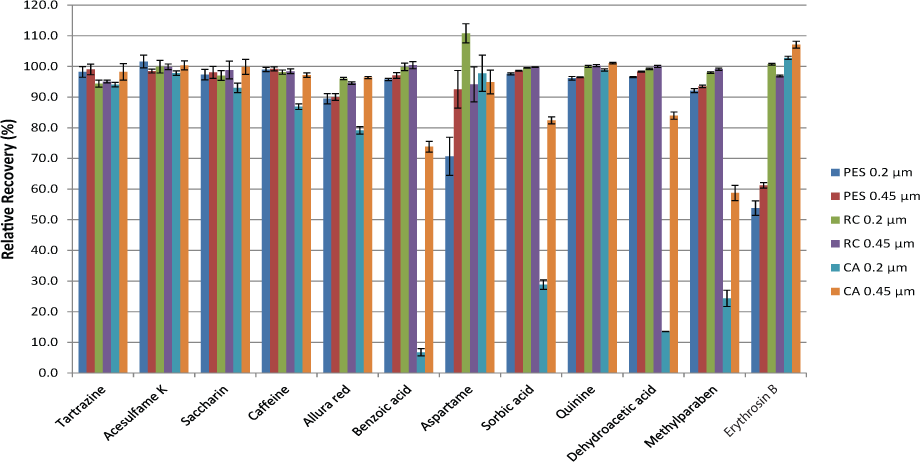
Filtration recovery evaluation results for 100% aqueous sample media, 95% confidence index, n = 6. Thirst Quencher samples directly filtered prior to HPLC injection, relative recovery (%) = normalized peak area ratio for filtered sample compared to a centrifuged sample.
Figure 2.
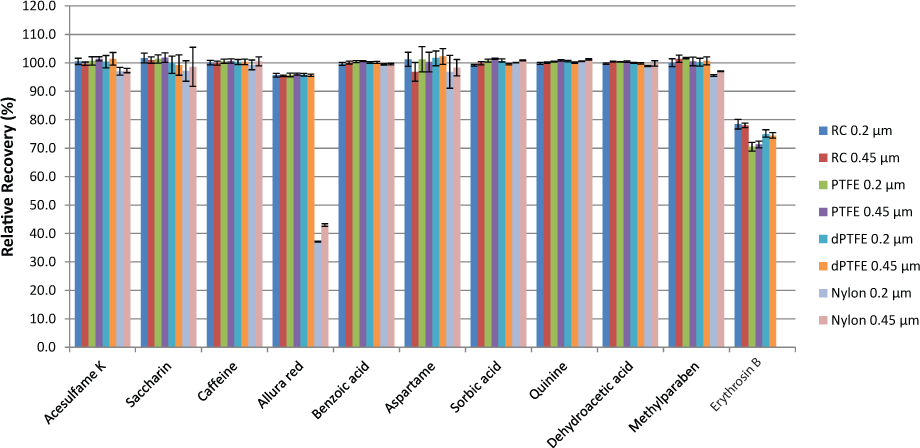
Filtration recovery evaluation results for aqueous/solvent sample media, 95% confidence index, n = 6. Dietary drink samples diluted with MeOH to generate a 1:1 MeOH:water sample medium, vortexed and filtered prior to HPLC injection, relative recovery (%) = normalized peak area ratio for filtered sample compared to centrifuged sample.